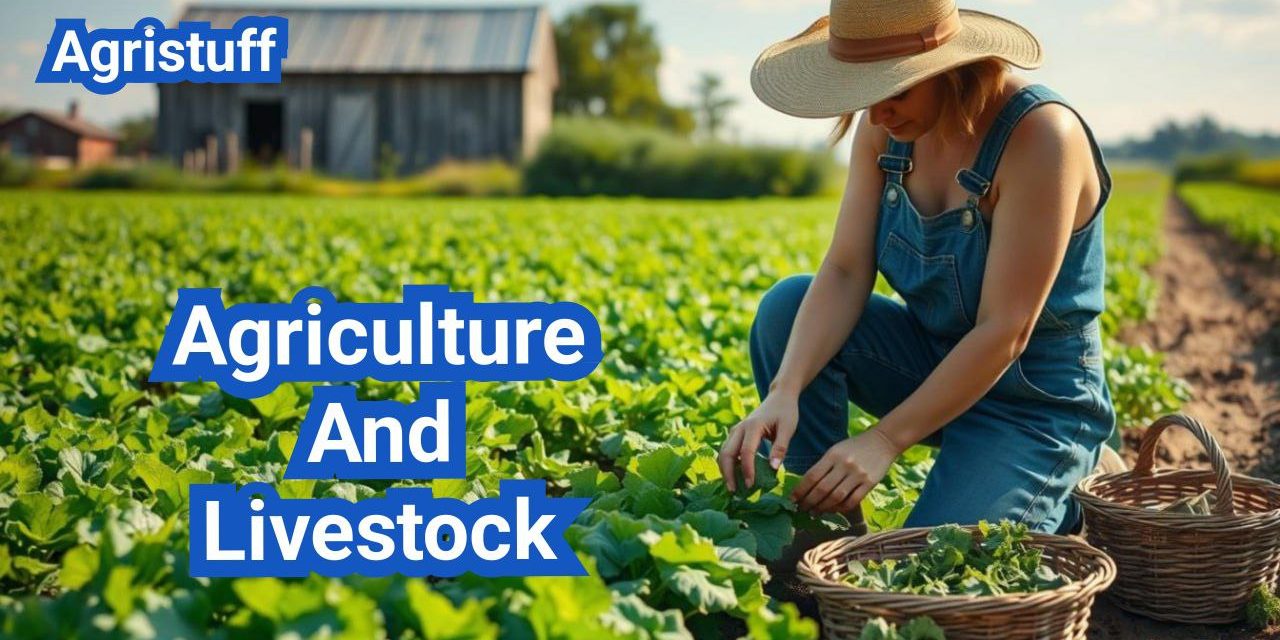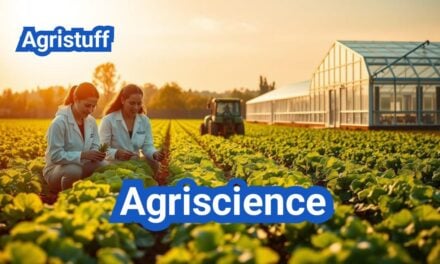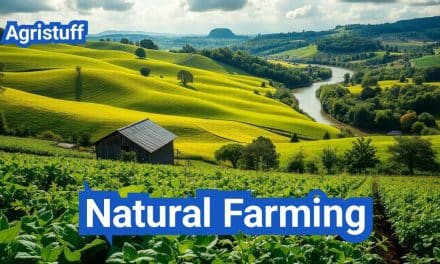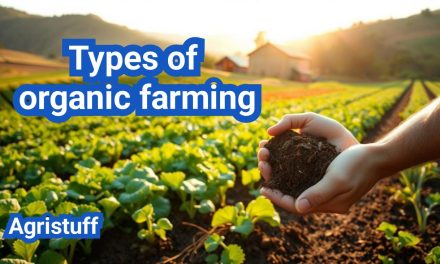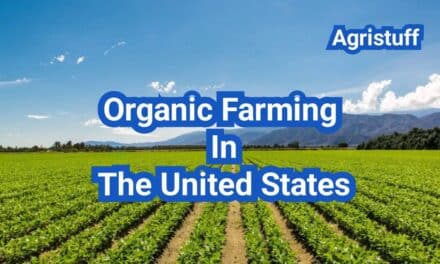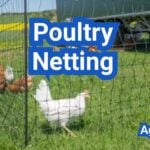Agriculture is the backbone of the global economy, providing sustenance to billions of people worldwide. As the global population continues to rise, the agricultural sector faces mounting pressure to meet food demands while adopting sustainable practices.
The importance of livestock farming cannot be overstated, as it provides a significant source of food, income, and employment for many communities. However, the sector is confronted with numerous challenges, including environmental degradation and the need for innovative farming techniques.
This comprehensive guide is designed to equip beginners with the knowledge and skills necessary to succeed in agriculture and livestock farming. By covering the basics of farming and providing insights into best practices, this guide aims to support newcomers to the industry.
Key Takeaways
- Understanding the significance of agriculture in the global economy
- Recognizing the challenges faced by the agricultural sector
- Gaining insights into the basics of livestock farming
- Learning about sustainable farming practices
- Acquiring knowledge to succeed as a beginner in agriculture
Understanding Agriculture And Livestock Basics
The foundation of successful farming lies in understanding the fundamentals of agriculture and livestock production. Modern farming practices have evolved significantly, incorporating technology and innovative methods to enhance crop yields and livestock production.
Defining Modern Farming Practices
Modern farming involves the use of advanced technology, such as precision agriculture and data analytics, to optimize farming operations. This includes the use of drones, satellite imaging, and IoT devices to monitor and manage crops and livestock more effectively.
Some key aspects of modern farming practices include:
- Precision agriculture techniques
- Use of technology for crop monitoring
- Efficient livestock management systems
- Sustainable farming methods
The Relationship Between Crops and Animals
The interdependence of crops and animals is a crucial aspect of farming. Crops provide feed for livestock, while animals contribute to soil fertility through manure, which in turn benefits crop production. This symbiotic relationship is fundamental to integrated farming systems.
Benefits of integrating crops and animals include:
- Improved soil health
- Increased biodiversity
- Enhanced farm productivity
- Better resource allocation
Why Start Farming in Today’s Economy
Despite the challenges, farming remains a viable and attractive venture in today’s economy. The demand for locally sourced and sustainable produce is on the rise, presenting opportunities for new farmers to capitalize on emerging markets.
Starting a farm can be economically rewarding due to:
- Growing demand for sustainable products
- Government support for new farmers
- Potential for diversification and value-added products
- Opportunities for direct-to-consumer sales
Assessing Your Resources and Goals

The journey to successful farming begins with a thorough assessment of your available resources and goals. This initial evaluation is crucial as it lays the foundation for your farming venture, helping you make informed decisions that can significantly impact your success.
Evaluating Available Land and Climate Conditions
Assessing the land you have available for farming is a critical first step. This involves not just measuring the acreage, but also understanding the topography, soil type, and climate conditions of your land. Climate conditions, in particular, play a significant role in determining what crops can be grown and what livestock can be raised.
- Examine the soil quality and its suitability for different crops.
- Consider the average rainfall and temperature ranges in your area.
- Assess the land’s topography to determine its suitability for certain farming practices.
Setting Realistic Farming Objectives
Setting clear and achievable goals is vital for the success of your farming operation. Your objectives should be aligned with your resources, including land, capital, and labor. Consider what you want to achieve in the short term and long term.
- Define your farming goals, whether it’s to produce a certain quantity of crops or raise a specific number of livestock.
- Develop a timeline for achieving these goals.
- Identify the resources needed to meet your objectives.
Determining Your Time and Financial Investment
Understanding the time and financial commitment required for farming is essential. This includes not just the initial investment but also ongoing expenses and the time needed to manage the farm effectively.
- Calculate the initial start-up costs, including land preparation, equipment, and initial stock.
- Estimate ongoing expenses such as feed, veterinary care, and equipment maintenance.
- Consider the time required for daily farm chores and management tasks.
By carefully assessing your resources and setting realistic goals, you can create a solid foundation for your farming venture. This thoughtful approach will help you navigate the challenges of farming and increase your chances of success.
Essential Equipment for Beginning Farmers
Equipping your farm with the necessary tools and technology is vital for maximizing productivity and profitability. As a beginner, understanding the essential equipment needed can be overwhelming, but it’s a crucial step towards a successful farming operation.
Basic Tools and Machinery
The foundation of any farm is its basic tools and machinery. These include tractors, plows, cultivators, and irrigation systems. Tractors are versatile machines that can be used for a variety of tasks, from plowing fields to hauling heavy loads. Plows are essential for preparing the soil for planting, while cultivators help control weeds and aerate the soil.
Key Machinery for Beginners:
- Tractor
- Plow
- Cultivator
- Irrigation system
- Seeder or planter
Investing in these basic machines can significantly improve the efficiency of your farming operations.
Storage and Processing Equipment
Once your crops are harvested, proper storage and processing are crucial to maintaining their quality. Storage facilities such as grain silos or cold storage units protect your produce from environmental damage. Processing equipment like threshers, cleaners, and sorters help prepare your crops for market.
| Equipment | Purpose |
|---|---|
| Grain Silo | Storage of grains |
| Cold Storage | Preservation of perishable crops |
| Thresher | Separating grains from chaff |
| Cleaner/Sorter | Cleaning and grading produce |
Technology and Farm Management Systems
Incorporating technology into your farming operation can greatly enhance efficiency and productivity. Farm management software helps in planning, monitoring, and managing your farm activities. Precision agriculture technologies, including GPS-guided equipment and drones, allow for more precise application of resources such as water and fertilizers.
“The use of technology in farming is not just about increasing yield; it’s about making farming more sustainable and environmentally friendly.”
— John Deere
By embracing these technologies, beginner farmers can make informed decisions, reduce waste, and improve their bottom line.
Land Preparation and Soil Management

Land preparation and soil management are interlinked practices that significantly impact farming outcomes. Effective soil management is crucial for maintaining soil health, which in turn affects crop yields and the overall sustainability of the farm.
Understanding Soil Types and Testing
Soil is a complex and varied medium that supports plant growth. Understanding the type of soil on your farm is essential for making informed decisions about land preparation and crop selection. Soil types can be broadly classified into clay, sandy, and loamy soils, each with its unique characteristics and management requirements.
Soil testing is a critical step in understanding soil health. It involves analyzing the soil’s pH level, nutrient content, and structure. Based on the test results, farmers can determine the necessary amendments to improve soil fertility and structure.
Preparing Land for Planting
Preparing the land for planting involves several steps, including clearing, tilling, and leveling the soil. Clearing removes debris and weeds that could compete with crops for water and nutrients. Tilling loosens the soil, improving aeration and water infiltration, while leveling ensures even distribution of water.
The method and extent of land preparation can vary depending on the soil type and the crops to be planted. For example, conservation tillage or no-till farming may be adopted to reduce soil erosion and preserve soil organic matter.
Sustainable Soil Conservation Techniques
Sustainable soil conservation is vital for maintaining soil health over the long term. Techniques such as crop rotation, cover cropping, and organic amendments help in maintaining soil fertility, reducing erosion, and improving soil structure.
Crop rotation involves changing the type of crops grown on a specific area of land from season to season. This practice helps in breaking pest and disease cycles, improving soil fertility, and increasing crop yields. Cover cropping involves planting crops between crop cycles to protect and enhance the soil.
| Technique | Benefits | Implementation |
|---|---|---|
| Crop Rotation | Improves soil fertility, breaks pest and disease cycles | Plan crop sequences based on soil and crop requirements |
| Cover Cropping | Protects soil, enhances soil health | Plant cover crops between main crops |
| Organic Amendments | Improves soil structure, fertility | Add compost or manure to the soil |
By adopting these sustainable soil conservation techniques, farmers can improve soil health, reduce environmental impact, and enhance the overall productivity of their farms.
Crop Selection for New Farmers
Crop selection is a foundational element for new farmers, impacting both the immediate and long-term success of their farming endeavors. Choosing the right crops can lead to higher yields, better resource allocation, and improved farm profitability.
Easy-to-Grow Crops for Beginners
For those new to farming, starting with easy-to-grow crops is advisable. Vegetables like lettuce, spinach, and radishes are excellent choices due to their hardiness and quick growth cycles. Grains such as oats and barley are also good options as they are relatively low maintenance and can thrive in various conditions.
Seasonal Planning and Crop Rotation
Understanding the importance of seasonal planning and crop rotation is crucial for maintaining soil health and optimizing crop yields. Seasonal planning involves selecting crops that are suitable for the current season, thereby reducing the risk of crop failure due to adverse weather conditions. Crop rotation, on the other hand, helps in maintaining soil fertility and structure, reducing pest and disease buildup.
For example, rotating between legumes and cereals can enhance soil nitrogen levels, benefiting subsequent crops. A well-planned crop rotation schedule can also help in managing pests and diseases more effectively.
Companion Planting Strategies
Companion planting is another valuable strategy for new farmers. This involves growing different crops together to improve their growth, health, or productivity. For instance, planting marigolds alongside tomatoes can help deter nematodes, while basil can enhance the flavor of nearby tomatoes and improve their resistance to pests.
By adopting companion planting strategies, farmers can create a more diverse and resilient agricultural ecosystem, potentially reducing the need for chemical pesticides and fertilizers.
Fundamentals of Agriculture And Livestock Integration

Integrating agriculture and livestock farming is a holistic approach that can significantly enhance farm productivity and sustainability. This method involves combining crop production and animal husbandry in a way that creates synergies between the two, leading to more efficient use of resources and reduced environmental impact.
Benefits of Mixed Farming Systems
Mixed farming systems offer several benefits, including improved biodiversity, enhanced farm productivity, and better resilience to economic and environmental challenges. By diversifying farm outputs, farmers can reduce their dependence on a single crop or livestock product, thereby spreading risk.
The integration of crops and animals also promotes ecological balance. For instance, crops can provide shade and shelter for animals, while animals can contribute manure that acts as a natural fertilizer for crops.
Creating Synergies Between Crops and Animals
Creating synergies between crops and animals is key to a successful integrated farming system. This can be achieved by carefully planning the farm’s layout and operations to maximize the benefits of both crops and livestock. For example, crop residues can be used as feed for animals, while animal manure can be used to fertilize crops.
Rotational grazing is another strategy that can enhance synergies between crops and animals. By rotating livestock through different grazing areas, farmers can improve soil health, reduce erosion, and promote more efficient use of pasture resources.
Resource Efficiency in Integrated Farming
Resource efficiency is a critical aspect of integrated farming. By utilizing resources such as land, water, and labor more effectively, farmers can reduce their operational costs and environmental footprint. For instance, using crop residues as animal feed or bedding can reduce waste and the need for external inputs.
A well-designed integrated farming system can also optimize the use of renewable resources. For example, farmers can use solar or wind power to meet their energy needs, further reducing their reliance on non-renewable resources.
| Benefits | Crop-Livestock Integration | Mixed Farming |
|---|---|---|
| Biodiversity | High | Medium |
| Resource Efficiency | High | Medium |
| Economic Resilience | High | Medium |
Choosing Livestock for Your Farm

Selecting the right livestock is a crucial decision for beginners in farming. The choice of livestock depends on several factors including farm size, available resources, and market demand. Beginners may start with small livestock like poultry or goats, which are relatively easier to manage.
Small Livestock Options for Beginners
Small livestock are ideal for beginners due to their relatively low maintenance costs and ease of handling. Some popular options include:
- Poultry: Chickens are a great starting point, providing eggs and meat.
- Goats: Goats are versatile, offering milk, meat, and fiber.
- Rabbits: Rabbits are another good option, providing meat and being relatively low maintenance.
These animals are not only easier to manage but also provide a quicker return on investment compared to larger livestock.
Larger Livestock Considerations
While larger livestock like cattle and pigs require more resources and space, they can be profitable if managed correctly. Considerations include:
- Space and Housing: Larger animals need more space and appropriate housing.
- Feed and Nutrition: The cost and logistics of feeding larger livestock can be significant.
- Market Demand: Understanding the demand for the products derived from larger livestock is crucial.
It’s essential for beginners to weigh these factors carefully and possibly start with smaller livestock before scaling up.
Animal Housing and Facilities

Creating suitable living conditions for your livestock is fundamental to successful farming. Proper animal housing not only enhances the welfare of your animals but also improves their productivity and overall health.
Basic Shelter Requirements by Species
Different livestock species have unique shelter requirements. For instance, poultry need protection from predators and harsh weather, while larger livestock like cattle require more spacious accommodations.
- Poultry: Coop structures with adequate ventilation, nesting boxes, and protection from predators.
- Cattle: Spacious barns or sheds that provide shelter from extreme weather conditions.
- Pigs: Pens that are well-ventilated and kept clean to prevent disease.
- Sheep and Goats: Sturdy fencing to prevent escape and predator protection.
Fencing and Containment Options
Effective fencing is crucial for keeping your livestock safe and secure. The type of fencing required can vary depending on the type of animals you are raising.
- For smaller animals like sheep and goats, high-tensile wire fencing is often recommended.
- Larger animals may require more robust fencing options, such as wooden or metal fencing.
- Electric fencing can be an effective and economical solution for containing livestock.
Creating Comfortable and Healthy Environments
Providing a comfortable and healthy environment for your livestock involves more than just shelter. It includes ensuring they have enough space to move, access to clean water, and a nutritious diet.
- Adequate ventilation is essential to prevent respiratory issues.
- Maintaining cleanliness in living areas helps prevent disease.
- Providing enough space for animals to move around reduces stress and improves overall health.
By focusing on these aspects, farmers can significantly improve the welfare and productivity of their livestock, leading to a more successful farming operation.
Livestock Health Management

Proper livestock health management involves a combination of preventative care, regular monitoring, and timely veterinary intervention. This comprehensive approach ensures the well-being of animals, enhances productivity, and contributes to the sustainability of the farm.
Preventative Care and Vaccination Schedules
Preventative care is the cornerstone of effective livestock health management. It includes regular vaccinations, parasite control, and nutritional management. Establishing a vaccination schedule is crucial for protecting livestock against common diseases.
- Consult with a veterinarian to determine the most appropriate vaccination schedule for your livestock.
- Keep accurate records of vaccinations and health checks for each animal.
- Implement a parasite control program to reduce the risk of internal and external parasites.
Common Health Issues and Treatments
Livestock can be susceptible to various health issues, including respiratory infections, hoof problems, and reproductive issues. Understanding these common health concerns and their treatments is vital for maintaining animal health.
| Health Issue | Common Symptoms | Treatment Options |
|---|---|---|
| Respiratory Infections | Coughing, labored breathing | Antibiotics, supportive care |
| Hoof Problems | Lameness, hoof lesions | Hoof trimming, topical treatments |
When to Call a Veterinarian
Knowing when to seek veterinary assistance is critical for addressing health issues promptly and effectively. Consult a veterinarian if you observe unusual symptoms, significant changes in behavior or appetite, or if an animal fails to respond to initial treatments.
Record Keeping for Animal Health
Maintaining detailed records of animal health is essential for tracking the health history of your livestock, identifying patterns, and making informed decisions about their care. Records should include vaccination history, health issues, treatments, and veterinary visits.
Feeding and Nutrition Fundamentals

Understanding the nutritional needs of your livestock is crucial for their overall health and productivity. Different species and even different stages of development within the same species have unique dietary requirements.
Understanding Animal Nutritional Needs
Livestock require a balanced diet that includes proteins, carbohydrates, fats, vitamins, and minerals. The specific nutritional needs can vary significantly between different types of livestock.
For instance, poultry require a diet rich in protein to support their rapid growth rate, while cattle may require more fiber to support their rumen health.
| Livestock Type | Primary Nutritional Needs |
|---|---|
| Poultry | High protein, balanced vitamins, and minerals |
| Cattle | High fiber, adequate protein, and specific minerals like calcium |
| Pigs | Balanced energy, protein, and essential amino acids |
Growing vs. Purchasing Feed
Farmers have two primary options for meeting their livestock’s nutritional needs: growing their feed or purchasing it. Growing feed can be cost-effective and allows for control over the quality and ingredients.
However, it requires suitable land and climate conditions. Purchasing feed can be more convenient but may be subject to market fluctuations in price and quality.
“The decision to grow or buy feed should be based on a thorough analysis of costs, available resources, and the specific needs of your livestock.”
Seasonal Feeding Adjustments
The nutritional needs of livestock can change with the seasons. For example, animals may require more energy during colder months to maintain body heat.
Adjusting feeding strategies seasonally can help ensure that livestock remain healthy and productive throughout the year.
- Monitor weather conditions and adjust feed accordingly.
- Provide more energy-rich feed during colder months.
- Ensure access to fresh water at all times.
By understanding and meeting the nutritional needs of your livestock, you can improve their health, productivity, and overall farm profitability.
Water Management for Crops and Animals

Effective water management is the backbone of any successful farming operation, ensuring that both crops and livestock receive the right amount of water at the right time. This critical aspect of farming directly impacts crop yields, livestock health, and overall farm productivity.
Irrigation Systems for Beginners
For those new to farming, understanding and implementing an appropriate irrigation system is crucial. Drip irrigation and sprinkler systems are popular choices among farmers due to their efficiency in delivering water directly to the roots of plants or across fields.
When selecting an irrigation system, consider factors such as water source, crop type, and land topography. It’s also essential to maintain the system regularly to prevent leaks and ensure optimal water distribution.
Water Conservation Techniques
Conserving water is not only environmentally friendly but also economically beneficial. Techniques such as mulching, cover cropping, and conservation tillage help retain soil moisture, reduce evaporation, and minimize the need for irrigation.
- Mulching around plants retains moisture and suppresses weeds.
- Cover crops help maintain soil health and structure, improving its water-holding capacity.
- Conservation tillage minimizes soil disturbance, preserving moisture and reducing erosion.
Ensuring Clean Water for Livestock
Providing clean water for livestock is as important as irrigating crops. Water quality directly affects animal health, impacting their growth, productivity, and overall well-being.
To ensure clean water, farmers should regularly test water sources for contaminants and implement measures to protect water sources from pollution. This might include fencing off water sources to prevent animal access or using water treatment systems when necessary.
By focusing on effective water management, farmers can improve crop yields, maintain healthy livestock, and contribute to a more sustainable agricultural practice.
Pest and Disease Management

Effective pest and disease management is crucial for the success of any agricultural or livestock farming operation. Farmers must employ a combination of techniques to manage pests and diseases, ensuring the health and productivity of their crops and livestock.
Integrated Pest Management Basics
Integrated Pest Management (IPM) involves using a variety of methods to manage pests, including cultural, biological, chemical, and physical controls. This holistic approach helps minimize the risk of pest resistance and reduces the environmental impact of farming practices.
- Cultural controls: modifying farming practices to prevent pest buildup
- Biological controls: using natural predators or parasites to control pests
- Chemical controls: applying pesticides judiciously
- Physical controls: using barriers or traps to manage pests
Natural and Chemical Control Methods
Farmers can choose from a range of natural and chemical control methods to manage pests. Natural methods include introducing beneficial insects, using organic pesticides, and practicing crop rotation. Chemical control methods involve the use of synthetic pesticides, which should be applied carefully to avoid environmental contamination and pest resistance.
| Control Method | Description | Advantages |
|---|---|---|
| Biological Control | Using natural predators or parasites | Environmentally friendly, targets specific pests |
| Chemical Control | Applying synthetic pesticides | Quick action, effective against a wide range of pests |
Preventing Disease Spread in Livestock
Preventing the spread of disease in livestock is critical for maintaining animal health and farm productivity. Measures include implementing strict biosecurity protocols, vaccinating animals, and monitoring animal health regularly.
By adopting these strategies, farmers can reduce the risk of disease outbreaks and ensure the well-being of their livestock.
Financial Planning and Farm Economics
Creating a robust financial plan is essential for farmers to navigate the complexities of modern farming. This involves understanding various financial aspects, including budgeting, operating costs, and accessing financial resources.
Creating a Realistic Farm Budget
A well-structured farm budget is the foundation of financial planning. It helps farmers allocate resources effectively, anticipate expenses, and make informed decisions. To create a realistic budget, farmers should start by identifying all potential income sources and expenses, including fixed costs like equipment and variable costs like seeds and fertilizers.
Farmers can use historical data and market trends to estimate revenues and expenses. It’s also crucial to include a contingency fund to address unexpected expenses or market fluctuations.
Understanding Operating Costs
Operating costs are a significant component of farm expenses. These include costs associated with planting, maintaining, and harvesting crops, as well as feeding and caring for livestock. Understanding these costs is vital for managing the farm’s finances effectively.
Farmers should regularly review their operating costs to identify areas where they can reduce expenses without compromising productivity. This might involve adopting more efficient farming practices or negotiating better prices with suppliers.
Accessing Agricultural Loans and Grants
Many farmers require external financing to support their operations. Agricultural loans and grants can provide the necessary capital for purchasing equipment, expanding operations, or covering operational expenses.
Farmers should explore various financing options, including government programs, private lenders, and cooperative financing. It’s essential to understand the terms and conditions of these financial products to make informed decisions.
Planning for Profit and Growth
Achieving profitability is a key goal for farmers. To plan for profit and growth, farmers must analyze their financial performance regularly, identifying areas for improvement and opportunities for expansion.
Strategies for enhancing profitability include diversifying products, improving efficiency, and exploring new markets. By adopting a proactive approach to financial management, farmers can build a sustainable and profitable farming business.
Marketing and Selling Your Farm Products
Marketing farm products effectively is key to a successful agricultural business, requiring a blend of traditional and modern techniques. As the agricultural landscape evolves, farmers must adapt their marketing strategies to reach consumers directly and build a loyal customer base.
Direct-to-Consumer Sales Strategies
Direct-to-consumer sales allow farmers to retain a larger share of the profit margin while building a personal connection with their customers. Strategies include:
- Establishing a farm stand or store on the farm premises
- Participating in local farmers’ markets
- Implementing a Community Supported Agriculture (CSA) program
These methods not only increase revenue but also provide valuable feedback from consumers, helping farmers tailor their production to meet market demands.
Working with Local Markets and Restaurants
Building relationships with local businesses can significantly expand a farm’s market reach. This involves:
- Supplying fresh produce to local restaurants and cafes
- Partnering with local grocery stores and specialty food shops
- Participating in local food festivals and events
Such collaborations can lead to consistent and substantial orders, providing a stable income stream for the farm.
Building Your Farm Brand
A strong brand identity helps differentiate a farm’s products in a crowded market. Key elements include:
- Developing a unique logo and brand messaging
- Creating attractive packaging that reflects the brand’s values
- Engaging in storytelling to share the farm’s mission and practices
Online Marketing for Small Farms
In today’s digital age, an online presence is crucial. Effective online marketing strategies for small farms include:
- Creating a professional website to showcase products and share the farm’s story
- Utilizing social media platforms to engage with customers and promote products
- Implementing email marketing campaigns to keep customers informed about new products and events
By leveraging these digital tools, small farms can reach a wider audience and compete more effectively in the marketplace.
To illustrate the potential of combining different marketing strategies, consider the following example of a farm that successfully integrated direct-to-consumer sales, local market partnerships, and online marketing.
| Marketing Strategy | Implementation | Outcome |
|---|---|---|
| Direct-to-Consumer Sales | Farmers’ market participation and CSA program | Increased customer loyalty and revenue |
| Local Market Partnerships | Supplying local restaurants and grocery stores | Expanded market reach and consistent orders |
| Online Marketing | Social media engagement and email marketing | Enhanced brand visibility and customer engagement |
Legal and Regulatory Considerations
Compliance with agricultural laws and regulations is vital for the sustainability of farming practices. As a farmer, understanding the legal landscape is crucial for avoiding potential pitfalls and ensuring the long-term viability of your operation.
Permits and Licenses for Small Farms
Before starting your farming venture, it’s essential to obtain the necessary permits and licenses. These may include business licenses, environmental permits, and health department permits, depending on your location and the type of farming you intend to do.
- Business licenses: Register your farm as a business entity and obtain any required local licenses.
- Environmental permits: If your farm will be using certain chemicals or managing waste, you may need environmental permits.
- Health department permits: For farms involved in selling products directly to consumers, such as through farmers’ markets or on-farm sales, health department permits may be required.
Understanding Agricultural Tax Implications
Farmers must navigate complex tax laws that are specific to agricultural operations. Understanding these tax implications can help you make informed decisions about your farm’s financial management.
Key tax considerations include:
- Income tax on farm profits
- Depreciation of farm equipment and assets
- Potential tax credits for conservation practices or renewable energy investments
| Tax Consideration | Description | Potential Benefits |
|---|---|---|
| Income Tax | Tax on profits from farm operations | Deductions for expenses, potential for lower rates |
| Depreciation | Reduction in value of farm assets over time | Reduces taxable income |
| Tax Credits | Credits for specific practices or investments | Direct reduction in tax liability |
Insurance Requirements for Farm Operations
Insurance is a critical component of risk management for farmers. Various types of insurance can protect against different risks, from crop failure to liability claims.
Common types of farm insurance include:
- Crop insurance to protect against crop failure or revenue loss
- Liability insurance to cover potential claims from accidents on your farm
- Property insurance to protect your farm buildings and equipment
By understanding and complying with legal and regulatory requirements, farmers can minimize risks and focus on building a successful and sustainable agricultural business.
Your Path to Successful Farming
Embarking on a farming journey can be both challenging and rewarding. With the right knowledge and planning, beginners can achieve success in agriculture and livestock farming. By understanding the basics of modern farming practices, assessing resources, and setting realistic goals, new farmers can lay the foundation for a thriving operation.
Key elements such as land preparation, crop selection, and livestock management all play crucial roles in achieving successful farming. Implementing effective water management, pest control, and financial planning strategies will further contribute to a farm’s prosperity.
As you begin your farming journey, remember that perseverance and continuous learning are essential. Staying informed about best practices, leveraging technology, and adapting to changes in the agricultural landscape will help ensure beginner’s success. By following the guidelines outlined in this comprehensive guide, you’ll be well on your way to establishing a productive and sustainable farm.
FAQ
What is the importance of agriculture and livestock farming in the global economy?
Agriculture and livestock farming play a crucial role in the global economy, providing food, employment, and income for millions of people worldwide.
What are the benefits of integrated farming systems?
Integrated farming systems, which combine crop and animal production, offer several benefits, including enhanced biodiversity, improved farm productivity, and more efficient use of resources.
How do I evaluate my resources for farming, including land and climate?
To evaluate your resources, assess your land’s suitability for farming, considering factors such as soil quality, climate, and topography, and determine the availability of water and other necessary resources.
What are the essential tools and machinery required for beginning farmers?
Basic tools and machinery, such as tractors, plows, and irrigation systems, are necessary for farming, as well as storage and processing equipment to handle and store crops and livestock products.
How do I prepare my land for planting, and what are the best soil conservation techniques?
To prepare your land, test your soil quality, and use techniques such as crop rotation, cover cropping, and contour farming to conserve soil and promote sustainable agriculture.
What are the best crops for beginners to grow, and how do I plan for seasonal variations?
Easy-to-grow crops, such as vegetables and grains, are suitable for beginners, and seasonal planning involves rotating crops, using companion planting strategies, and adjusting to changing weather conditions.
How do I choose the right livestock for my farm, and what are the considerations for small versus larger livestock?
When choosing livestock, consider factors such as farm resources, market demand, and the pros and cons of small versus larger livestock, and select breeds that are well-suited to your climate and management system.
What are the basic shelter requirements for different livestock species, and how do I create a comfortable and healthy environment?
Provide suitable shelter for your livestock, considering factors such as ventilation, temperature, and sanitation, and ensure adequate fencing and containment to prevent escape or predation.
How do I manage livestock health, including preventative care and vaccination schedules?
Implement a health management plan, including regular veterinary check-ups, vaccinations, and parasite control measures, to maintain the health and well-being of your livestock.
What are the nutritional requirements of different livestock species, and how do I make seasonal adjustments to feeding strategies?
Understand the nutritional needs of your livestock, and adjust feeding strategies according to seasonal changes, using a combination of grazing, stored feed, and supplements as necessary.
How do I manage water resources efficiently, including irrigation systems and water conservation techniques?
Implement efficient irrigation systems, and use water conservation techniques, such as mulching and drip irrigation, to minimize water waste and optimize water use for crops and livestock.
What are the best strategies for managing pests and diseases in crops and livestock?
Use integrated pest management (IPM) strategies, including natural and chemical control methods, to manage pests and diseases, and implement biosecurity measures to prevent disease spread in livestock.
How do I create a realistic farm budget, and what are the key operating costs to consider?
Develop a comprehensive farm budget, considering factors such as input costs, labor, and equipment expenses, and regularly review and adjust your budget to ensure financial sustainability.
What are the marketing strategies for selling farm products, and how do I build my farm brand?
Use direct-to-consumer sales strategies, such as farmers’ markets and community-supported agriculture (CSA) programs, and build your farm brand through online marketing, social media, and other promotional activities.
What are the key legal and regulatory considerations for farmers, including permits, licenses, and insurance requirements?
Familiarize yourself with relevant laws and regulations, obtain necessary permits and licenses, and ensure adequate insurance coverage to protect your farm business from risks and liabilities.
How do I access agricultural loans and grants, and what are the available financial resources for farmers?
Explore available financial resources, such as government programs, non-profit organizations, and commercial lenders, and develop a strong business plan to support your loan or grant application.
Conclusion Of: Agriculture And Livestock Farming
Agriculture and livestock farming is an admirable and rewarding endeavor for newcomers who want to connect with the land, raise animals responsibly, and contribute to food security. In this comprehensive guide, we walk beginners through everything—from getting started and selecting farm types to essential management practices and future trends.
Understanding Agriculture and Livestock Basics
In the realm of agriculture and livestock, you’re combining plant cultivation and animal husbandry in one holistic system. Crop production often includes grains, vegetables, and forage, while livestock covers cattle, sheep, poultry, goats, and more. This synergy creates natural cycles: crops supply feed, animals provide manure for fertilizing soil, leading to a more sustainable operation. Learn more about integrated farming systems from the USDA.
Understanding how crops and animals interact—and affect each other—is foundational. Each complements the other, forming a balanced system that reduces waste, lowers reliance on external inputs, and enhances biodiversity.
Benefits of Agriculture and Livestock Integration
Why focus on agriculture and livestock integration? First, it boosts efficiency: animals graze on crop residues, and their manure enriches soil. Second, it builds resilience: diverse systems are more stable in the face of market swings, weather events, or disease outbreaks. Third, it’s environmentally sound: proper rotations and grazing can improve soil health, reduce erosion, and even sequester carbon—particularly through practices like silvopasture and rotational grazing. Explore sustainable livestock-crop integration from FAO.
Research & Planning: Step One in Agriculture and Livestock Farming
Launching into agriculture and livestock requires research and planning. Ask yourself: What species make sense for my region? What do I most want to produce—milk, meat, eggs, fiber, grains, or vegetables? Consider climate, land type, water access, local regulations, and markets. Building a thorough business plan now can anchor your success later. Get a step-by-step farming business plan guide from Farmers.gov.
Soil, Water & Land Assessment in Agriculture and Livestock
Healthy soil is your foundation. Test soil for nutrients, structure, and pH. Learn irrigation options—sprinklers, drip lines, or rainwater harvesting. Look into local programs for guidance and potential funding. Check soil testing recommendations from the NRCS.
Choosing Livestock for Your Agriculture and Livestock Operation
Incorporating agriculture and livestock means picking animals that align with your goals and experience. Cattle and sheep are popular for grass-based systems; poultry and small ruminants are suitable for smaller setups. Hair sheep like Katahdins are forgiving for beginners. Chickens are easy to manage, providing eggs and pest control. Find beginner-friendly livestock options from Penn State Extension.
Rotational Grazing & Pasture Management
Rotational grazing is a core practice for agriculture and livestock systems: moving animals through paddocks allows forage to recover and boosts soil health. Farmers using rotational grazing see more resilient pastures, fewer disease outbreaks, and lower erosion risk. Learn rotational grazing techniques from SARE.
Silvopasture: Combining Trees with Livestock
Silvopasture integrates trees, animals, and forage, delivering shade, shelter, and diversified income through timber or fruit. It improves biodiversity, microclimate, and carbon sequestration compared to open fields. Discover silvopasture benefits from the USDA Agroforestry Center.
Animal Welfare & Good Agricultural Practices
In any agriculture and livestock venture, animal welfare is non-negotiable. Follow Good Agricultural Practice guidelines: provide clean water, nutritious feed, shelter, prevent overcrowding, minimize stress, avoid unnecessary medications, and maintain traceability. Review animal welfare standards from the American Veterinary Medical Association.
Modern Technologies in Agriculture and Livestock
Technology is transforming agriculture and livestock through precision tools, wearable sensors, and digital monitoring. Dairy farms are placing smart collars and ear tags on cows to track health, feed intake, and movement—enabling early disease detection and lowering labor needs. Explore precision livestock farming from the University of Nebraska-Lincoln.
Precision Livestock Farming
Precision livestock farming leverages sensors, cameras, microphones, and software to monitor each animal’s well-being, growth, and reproductive status. This enables efficient care across large herds.
Crop Technology in Agriculture and Livestock Context
The crop side of the equation also benefits from technology within agriculture and livestock systems. Precision agriculture—using drones, GPS-guided machinery, IoT sensors, and AI—optimizes irrigation, soil care, planting, and harvesting, complementing animal husbandry in a full circular system. Learn about precision agriculture from the USDA.
Building Infrastructure for Agriculture and Livestock Farming
Set up essential infrastructure: fencing for rotation, barns or shelters, water systems, handling areas, equipment for planting and harvesting, and feed storage. Robust planning saves headaches later. Get infrastructure planning tips from the National Young Farmers Coalition.
Nutrition & Feed Management
Proper nutrition is key in agriculture and livestock systems. Pastures can supply much of the diet if well managed, but supplements may be needed—especially in winter, drought, or pre-breeding. Work with an animal nutritionist or veterinarian to balance diets for health and performance. Find livestock nutrition guides from the University of Minnesota Extension.
Herd Health Management
Preventing disease is more effective than treatment. Establish biosecurity measures: quarantine new animals, maintain clean environments, control pests, vaccinate, and schedule routine vet visits. Wearable tech helps detect early illness, reducing cost and stress. See biosecurity best practices from the CDC.
Marketing & Finding Buyers for Agriculture and Livestock Products
Successful agriculture and livestock farming includes finding markets. Options include:
- Direct-to-consumer sales through farmers markets or CSA models
- Wholesale to local restaurants and grocery stores
- Value-added goods (cheese, yogurt, smoked meats)
- Agrotourism—farm tours, workshops, pick-your-own experiences
Investigate local demand, pricing, regulations, and branding to carve your niche. Get marketing strategies from the USDA Agricultural Marketing Service.
Risks & Resilience in Agriculture and Livestock
All agriculture has risks: weather, market volatility, pests, disease. For agriculture and livestock, add livestock diseases or feed price spikes. Practices like rotational grazing, silvopasture, diversified species, animal monitoring tech, and strong market channels help build resilience. Learn risk management from the USDA Risk Management Agency.
Financial Planning & Funding Options
Budget for land or equipment, infrastructure, feed, veterinary expenses, and insurance. Look into resources like beginning farmer loans, grants, crop insurance, and conservation cost-sharing through extension programs. Explore funding options from the USDA Farm Service Agency.
Sustainable Practices & Climate-Friendly Farming
Integrating sustainable methods within agriculture and livestock systems provides environmental and business benefits:
- Rotational grazing and silvopasture enhance carbon sequestration
- Precision tech reduces resource waste
- Reduced antibiotics and better welfare align with Good Agricultural Practice
These practices also meet growing consumer demand for responsibly produced food. See sustainable farming methods from the National Sustainable Agriculture Coalition.
Regulatory Compliance & Record-Keeping
Stay compliant in agriculture and livestock with local and federal regulations. Keep thorough records of animal purchases, treatments, feed sources, sales, and financials. Traceability is essential for food safety and farm credibility. Check USDA record-keeping guidelines.
Staying Informed & Community Engagement
Join farming networks, attend local workshops, and use extension services. Keep updated on:
- Beef herd supply being historically tight and prices high
- Screwworm outbreaks halting imports from Mexico
- Growth of solar grazing with sheep in the U.S.
Understanding these trends helps you adapt and leverage opportunities. Find extension resources from eXtension.
Future Outlook of Agriculture and Livestock
The future of agriculture and livestock is driven by innovation: precision farming, AI-based health detection for cows, drones for forage monitoring, and digital data tools will all shape next-generation farming. Sustainable systems like silvopasture and rotational grazing will likely see more support as climate-smart strategies. Read about future farming trends from the ICL Group.
Step-by-Step Checklist To Get Started
- Define your farm’s goals (meat, milk, grains, vegetables, fiber).
- Analyze your land—soil tests, water access, zoning.
- Choose livestock suited to your scale and goals.
- Draft a business plan and budget.
- Design pasture systems and infrastructure.
- Implement grazing rotations and sustainable pasture practices.
- Source healthy animals from reputable breeders.
- Set up nutrition plans and vet protocols.
- Use tech (sensors, app tracking) for monitoring.
- Secure markets and develop marketing strategies.
- Maintain records, licenses, and insurance.
- Continuously learn—from extension workshops to networking.
Common Beginner Mistakes & How to Avoid Them
- Overcommitting animals on poor pasture—start small and expand.
- Underestimating feed and water needs—have buffers for drought.
- Skimping on infrastructure—invest sensibly in handling, fencing, shelter.
- Ignoring market research—don’t produce what you can’t sell.
- Skipping record-keeping—documentation underpins success.
Inspirational Success Stories in Agriculture and Livestock
Many modern farms blend multi-enterprise systems—raising cattle, sheep, poultry, growing grains—and integrating solar grazing, agritourism, and value-added products. These farms show how diverse agriculture and livestock operations can thrive by combining innovative techniques with strong community ties.
Final Thought
Agriculture and livestock farming for beginners can be transformative—offering connection to nature, community engagement, and contribution to food security. Success lies in thoughtful planning, sustainable practices, continuous learning, and leveraging modern tools. By focusing on integrated systems—rotational grazing, silvopasture, precision tech—you can build a resilient, profitable farm. With patience, support, and passion, your agriculture and livestock journey can flourish and leave a lasting legacy.

